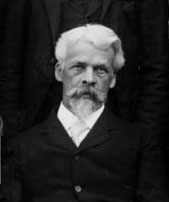- Introduction
- ES Morse
- Morse in New England
- Morse as an illustrator
- Morse in Japan
- Morse's pottery collection
- Charles Otis Whitman
- Shosaburo Watase
- Umeko Tsuda and Sutematsu Yamakawa
- Katsuma Dan
- Emperor Showa (Hirohito)
- Shinya Inoue
- Osamu Shimomura
- Susumu Honjo
- --------
- E.S. Morse Institute
- Institutional Cooperation
- Fukushima
- About
Charles Otis Whitman 1842-1910

Charles Otis Whitman. From the WHHM Archive. This is a detail of a Balwdin Coolidge photo.
After graduating from Bowdoin College in 1868, Whitman taught school for five years. Then, in 1873 he enrolled to become one of fifty participants in the first session of the summer marine biology program at the Anderson School of Natural History on Penikese Island taught by Harvard University Professor of Zoology Louis Agassiz, who was assisted by E. S. Morse. This experience had a profound impact on Whitman as well as on most of Agassiz’s students. In 1874 Whitman joined the Boston Society of Natural History and, after a second summer at Penikese, decided to dedicate himself to the full-time study of zoology, but he was never to forget the vitality and enthusiasm of that seaside laboratory.
In 1875 Whitman went to study in Europe under Anton Dohrn at his marine lab, the Stazione Zoologica in Naples. After working with Dohrn in Naples, Whitman and his fellow Penikese Island student Charles Sedgwick Minot moved to Leipzig, Germany. There, under the direction of parasitologist Rudolf Leuckart, he learned the modern methods of embryology and microscopy, and earned his PhD.
In 1879 he was offered a postdoctoral fellowship at Johns Hopkins University but turned it down when Edward S. Morse invited him to take his place as Professor of Zoology at the Imperial University of Tokyo. Whitman spent two influential years there: eight of his students went on to become prominent zoologists, including four who held major chairs, affording him the informal title “father of zoology” in Japan.
From November 1881 until May 1882, Whitman returned to the Stazione Zoologica to study, then moved to Boston to work as an assistant to Alexander Agassiz at the Museum of Comparative Zoology at Harvard University, a position that Morse had held earlier. During this time Whitman also served as the editor for the Department of Microscopy at the American Naturalist Magazine. In 1888 Whitman was invited to direct the newly established Marine Biological Laboratory in Woods Hole, a position he held until 1908. As he assumed his directorship of the new summer lab, he invoked the perfection of the Penikese lab, holding it up as the standard to strive for.
In 1889 Whitman took the position of Chair of Zoology at Clark University in Worcester, Massachusetts. In 1892 Whitman moved again to become Head of the Biology Department at the newly founded University of Chicago. There Whitman had several students who went on to make names for themselves in embryology. One of the most prominent was Frank Rattray Lillie, who succeeded Whitman as both the director at the MBL, and as head of the biology department at the University of Chicago. Whitman had many embryologist colleagues at Chicago, including not only Lillie, but also Jacques Loeb, Shosaburo Watase, and William Morton Wheeler. Whitman remained at the University of Chicago and the MBL until his death on December 6, 1910.